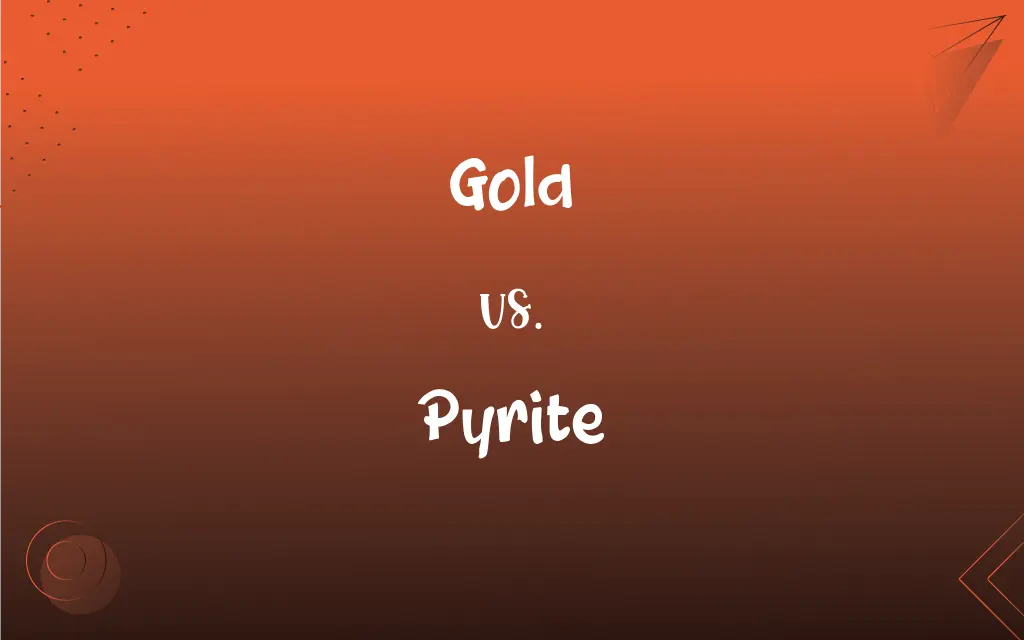Gold vs. Pyrite: What's the Difference?
Edited by Janet White || By Harlon Moss || Published on December 11, 2023
Gold is a dense, valuable, yellow metal, highly malleable and ductile, used in jewelry and as an investment; Pyrite, also known as fool's gold, is a less dense, brass-yellow mineral with a metallic luster, commonly mistaken for gold.

Key Differences
Gold, known for its captivating, bright yellow sheen, has been a symbol of wealth and beauty for centuries. Pyrite, on the other hand, often fools the inexperienced eye with its similar brass-yellow hue, but it lacks the same richness and depth of color.
The density of gold is significantly higher than that of pyrite. While gold is one of the densest metals, easily malleable and ductile, pyrite is harder, more brittle, and cannot be reshaped as easily as gold.
Gold is a chemical element with the symbol Au and is highly unreactive, resisting tarnish and corrosion. Pyrite, composed of iron and sulfur (FeS2), is prone to oxidation and degradation, especially when exposed to air and moisture.
Gold's value, both monetary and cultural, has been unparalleled, often used in jewelry, currency, and as an investment. Pyrite, despite its deceptive appearance, holds little intrinsic value and is often collected as a novelty or used in industrial processes.
Comparison Chart
Color
Bright yellow
Brass-yellow
ADVERTISEMENT
Hardness
Soft and malleable
Hard and brittle
Chemical Composition
Elemental metal (Au)
Iron sulfide (FeS2)
Market Value
High, used as currency and investment
Low, mostly collected as a novelty
Reaction to Air
Does not tarnish or corrode
Prone to oxidation and degradation
Gold and Pyrite Definitions
Gold
Gold has been used as a form of currency and investment.
Countries often hold reserves of gold to back their currency.
ADVERTISEMENT
Pyrite
Pyrite is often called fool's gold due to its deceptive resemblance to real gold.
The novice prospector was disappointed to find pyrite instead of real gold.
Gold
Gold refers to a bright yellow color, often associated with wealth and success.
The sunset painted the sky in shades of gold.
Pyrite
Pyrite is chemically known as iron sulfide (FeS2).
Pyrite, or iron sulfide, is often found in sedimentary rocks.
Gold
Gold symbolizes something of the highest quality or value.
Their team is the gold standard in customer service.
Pyrite
Pyrite is a common sulfide mineral known for its metallic luster.
He found a piece of pyrite while hiking in the mountains.
Gold
Gold is a highly valued, precious metal used in jewelry.
The gold necklace she wore was a family heirloom.
Pyrite
In historical contexts, pyrite was used to create sparks for starting fires.
Before matches, pyrite was used with flint to light fires.
Gold
Gold denotes the highest achievement, as in a gold medal.
She won gold in the Olympic swimming competition.
Pyrite
Pyrite forms in distinct crystal shapes, adding to its appeal for collectors.
The pyrite crystals in the museum were beautifully formed.
Gold
Symbol Au A soft, yellow, corrosion-resistant element, the most malleable and ductile metal, occurring in veins and alluvial deposits and recovered by mining, panning, or sluicing. A good thermal and electrical conductor, gold is generally alloyed to increase its strength, and it is used as a common monetary standard, in jewelry, for decoration, and as a plated coating on a wide variety of electrical and mechanical components. Atomic number 79; atomic weight 196.967; melting point 1,064.2°C; boiling point 2,856.0°C; specific gravity 19.3; valence 1, 3. See Periodic Table.
Pyrite
A brass-colored mineral, FeS2, occurring widely and used as an iron ore and in producing sulfur dioxide for sulfuric acid. Also called fool's gold, iron pyrites.
Gold
Coinage made of this element.
Pyrite
(mineral) The common mineral iron disulfide (FeS2), of a pale brass-yellow color and brilliant metallic luster, crystallizing in the isometric system.
Pyrite
(usually as a plural: pyrites) Any metallic-looking sulphide, such as the above, which is the most common.
Pyrite
(usually as a plural: pyrites) Any metal dichalcogenide that is isostructural to the common mineral.
Copper diselenide can occur both as a marcasite and a pyrite.
Pyrite
A common mineral of a pale brass-yellow color and brilliant metallic luster, crystallizing in the isometric system; iron pyrites; iron disulphide.
Hence sable coal his massy couch extends,And stars of gold the sparkling pyrite blends.
Pyrite
A common mineral (iron disulfide) that has a pale yellow color
FAQs
What is pyrite?
Pyrite is a brass-yellow mineral, also known as fool's gold, composed of iron sulfide (FeS2).
What is gold?
Gold is a precious metal known for its bright yellow color, malleability, and use in jewelry and currency.
Is gold used in electronics?
Yes, gold's excellent conductivity and resistance to corrosion make it valuable in electronics.
Does gold tarnish?
Gold does not tarnish or corrode, maintaining its luster over time.
Why is gold valuable?
Gold is valuable due to its rarity, beauty, and historical significance as a form of currency and symbol of wealth.
What are the industrial uses of pyrite?
Pyrite is used in the production of sulfuric acid and in the paper industry.
Where is pyrite commonly found?
Pyrite is commonly found in sedimentary rocks, coal beds, and as a replacement mineral in fossils.
What is the chemical symbol for gold?
The chemical symbol for gold is Au.
Can pyrite be mistaken for gold?
Yes, pyrite's similar color can lead to confusion, earning it the nickname "fool's gold."
Does pyrite have any historical uses?
Historically, pyrite was used in flintlock firearms and to start fires before the invention of matches.
Does pyrite have any value?
Pyrite has some industrial value and is collected for its aesthetic appeal but is not valuable like gold.
Is pyrite used in jewelry?
While not common, pyrite is sometimes used in costume jewelry for its unique appearance.
What is the chemical formula for pyrite?
The chemical formula for pyrite is FeS2.
What is the historical significance of gold?
Gold has been historically significant in many cultures as a symbol of wealth, power, and beauty.
How can you distinguish gold from pyrite?
Gold is denser, softer, and has a different color sheen compared to the harder and more brittle pyrite.
Where is gold commonly found?
Gold is often found in alluvial deposits, veins, and sometimes in association with quartz.
How is gold extracted?
Gold is extracted through mining and refining processes, including panning, sluicing, and chemical extraction.
Can gold be artificially created?
Gold cannot be economically synthesized, but minute quantities have been produced in particle accelerators.
Is pyrite magnetic?
Pyrite is weakly magnetic, unlike gold.
How is gold purified?
Gold is purified through processes like smelting and electrolysis to achieve high purity levels.
About Author
Written by
Harlon MossHarlon is a seasoned quality moderator and accomplished content writer for Difference Wiki. An alumnus of the prestigious University of California, he earned his degree in Computer Science. Leveraging his academic background, Harlon brings a meticulous and informed perspective to his work, ensuring content accuracy and excellence.
Edited by
Janet WhiteJanet White has been an esteemed writer and blogger for Difference Wiki. Holding a Master's degree in Science and Medical Journalism from the prestigious Boston University, she has consistently demonstrated her expertise and passion for her field. When she's not immersed in her work, Janet relishes her time exercising, delving into a good book, and cherishing moments with friends and family.






































































